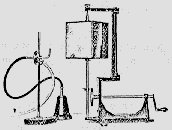Rudolph Koenig
| Karl Rudolph Koenig | |
|---|---|
 | |
| Born |
November 26, 1832 Königsberg, Prussia |
| Died |
October 2, 1901 (aged 68) Paris, France |
Karl Rudolph Koenig (German: Rudolf Koenig; November 26, 1832 – October 2, 1901), known by himself and others as Rudolph Koenig, was a German physicist, chiefly concerned with acoustic phenomena.
Biography

Koenig was born in Königsberg (Province of Prussia), and studied at the University of Königsberg in his native town.
About 1852 he went to Paris, and became apprentice to the famous violin-maker, Jean Baptiste Vuillaume (1798-1875), and some six years later he started business on his own account. He called himself a "maker of musical instruments," but the instrument for which his name is best known is the tuning fork. Koenig's work speedily gained a high reputation among physicists for accuracy and general excellence. From this business Koenig derived his livelihood for the rest of his life. One of his last catalogs had 262 different items.
He was, however, very far from being a mere tradesman. Acoustical research was his real interest, and to that he devoted all the time and money he could spare from his business. In the 1860s, the Koenig sound analyzer revolutionized musical and scientific worlds by demonstrated visually that musical notes and voices were in fact made up of simple sounds.[1] An exhibit which he sent to the London Exhibition of 1862 gained a gold medal, and at the Philadelphia Exposition at 1876 great admiration was expressed for a tonometric apparatus of his manufacture. This consisted of about 670 tuning-forks, of as many different pitches, extending over four octaves, and it afforded a perfect means for testing, by enumeration of the beats, the number of vibrations producing any given note and for accurately tuning any musical instrument. An attempt was made to secure this apparatus for the University of Pennsylvania, and Koenig was induced to leave it behind him in America on the assurance that it would be purchased; but, ultimately, the money not being forthcoming, the arrangement fell through, to his great disappointment.
Some of the forks he disposed of to the University of Toronto and the remainder he used as a nucleus for the construction of a still more elaborate tonometer. While the range of the old apparatus was only between 128 and 4096 Hz, the lowest fork of the new one vibrated at only 16 Hz, while the highest gave a sound too high to be perceptible to the human ear.

Koenig will also be remembered as the inventor and constructor of many other beautiful pieces of apparatus for the investigation of acoustical problems, among which may be mentioned his wave-sirens, the first of which was shown at Philadelphia in 1876. His original work dealt, among other things, with Wheatstone's sound-figures, the characteristic notes of the different vowels, a manometric flame apparatus, a vibration microscope, among others; but perhaps the most important of his researches are those devoted to the phenomena produced by the interference of two tones, in which he disputed the views of Helmholtz as to the existence of summation and difference tones.
He died in Paris.
References
- ↑ Artifact Spotlight - Rudolph Koenig's Sound Analyzer, Canada Science and Technology Museum.
External links
- Koenig's Manometric Flame Apparatus
- Koenig's Vibration Microscope
- Koenig's Fourier Analyser
- Biography and bibliography in the Virtual Laboratory of the Max Planck Institute for the History of Science
Source
![]() This article incorporates text from a publication now in the public domain: Chisholm, Hugh, ed. (1911). Encyclopædia Britannica (11th ed.). Cambridge University Press
This article incorporates text from a publication now in the public domain: Chisholm, Hugh, ed. (1911). Encyclopædia Britannica (11th ed.). Cambridge University Press
|